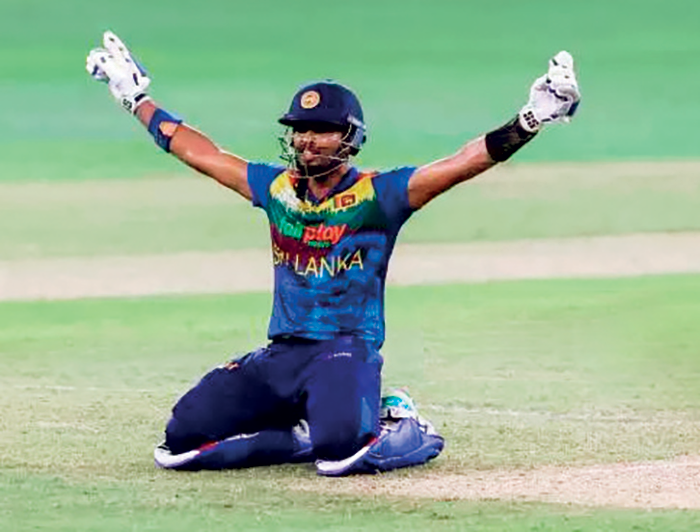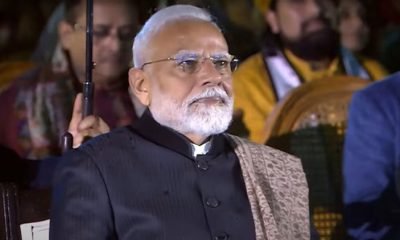Sports
Captain Dasun has helped Sri Lanka turn things around

by Rex Clementine
Cricket’s most successful captains had some remarkable factors that made them successful leaders. Mike Brearley was a good thinker. Clive Lloyd was inspirational. Imran Khan had a good eye for picking talent. Arjuna Ranatunga was a fighter and two of his prodigies Sanath Jayasuriya and Mahela Jayawardene had factors unique to them. While Sanath led by example, MJ was a brilliant tactician. All successful players don’t become good captains either. Brian Lara, Sachin Tendulkar and Inzamam-ul-Haq are cases in point.
Sri Lanka’s white-ball captain Dasun Shanaka has been the subject of discussions by cricket analysts for turning the fortunes of an inexperienced, young and underperforming Sri Lankan team into a successful unit. Last week he sealed the fate of Bangladesh and Afghanistan in the Asia Cup and this week he provided another shock when India were sent home packing. What makes him successful?
Dasun wasn’t the choice to lead Sri Lanka when the national selection panel benched half a dozen seniors two years ago. He wasn’t even the deputy. Kusal Perera turned out to be the chosen one with Kusal Mendis as his deputy. The selectors argued that KJP was the only player in the team who was sure of a place. That argument is ancient. When you try to be progressive, you don’t stick to age-old theories. For a selection panel that had been ruthless in leaving out so many seniors, they needed an equally aggressive captain. When you have revamped a team you needed a new direction.
KJP is one of the nicest blokes you’d come across in cricket, but his leadership qualities were found wanting. To start with he was injury prone. He’s also a bit of an introvert. The new captain found himself in a bit of a storm following the contract crisis coupled with injuries and that experiment didn’t last long.
Dasun had become captain by default with the team in total chaos. A heavy defeat in England in 2021 saw commentators ridiculing the team and to make matters worse three players were sent home for breaching COVID protocol. When Dasun agreed to take the captaincy it was demanded that he signed contracts. He agreed. This was a gamble and perhaps angered some of the players who were on the war path with the board. He was on a tightrope. The initial few series were tough but he gradually turned things around.
Dasun-Mickey Arthur combination worked well. Although their disagreements were once seen in public the duo were quick to patch things up and move forward. They picked young players and backed them and more importantly persevered when things were falling apart.
“Dasun is special in that he has great belief in himself and empowers the team. He leads by example in his performance, training and practice and has the ability to take people on the journey with him,” Arthur told Sunday Island.
As captain, he’s not the sharpest guy when it comes to tactics. His strength is his focus and getting others to focus. He’s also not the most naturally talented player. He’s one of the fiercest hitters in the team but his defence can be breached. The best thing that has happened to Dasun the batsman is he has identified his strong areas and sticks to them. You don’t see him cutting, but you’ll see him clearing the boundary with straight hits or pulling over mid-wicket. Those are strokes that he has mastered and they fetch most of his runs.
As a bowler, he doesn’t cover himself in glory. Again, his strength is that he puts in the hard yards and wants to improve. Those are Dasun’s strong points. Since Sri Lanka won the Asia Cup in 2014, it’s been all downhill in white ball cricket. Leave alone winning tournaments, the team is nowadays struggling to qualify for events like the World Cup. Dasun has given new hope to the nation with his unique leadership qualities. He needs to be backed.
Latest News
Chapman, Abbas and Smith see off Pakistan challenge to give New Zealand 1-0 series lead

Mark Chapman inflicted misery upon his favourite opponents once more, a career-best 132 off 111 balls helping New Zealand to a 73-run victory in Napier. A strong start from Pakistan’s bowlers came undone by a 199-run fourth wicket partnership between Chapman and Daryl Mitchell, whose grittier 76 came in the slipstream of Chapman’s more regal knock. It was topped off by a cameo from Pakistan-born New Zealand debutant Muhammad Abbas, who scored the quickest 50 on debut in ODI history, taking 24-balls to get there as the hosts posted 344.
Pakistan’s response for large periods suggested they were well on course for victory. Fifties from Babar Azam and Salman Agha put Pakistan in pole position before Pakistan collapsed from 249 for 3 to 271 all out, losing three wickets for four runs as New Zealand turned the tables to seal a victory that was, for long periods, less comfortable than the final scorecard.
When Mohammad Rizwan won the toss and bowled first, it appeared a masterstroke. The seam bowlers were hooping it round corners, the life in the pitch presenting challenges New Zealand’s top order was finding insurmountable. Naseem Shah had Will Young nick off early while debutant Nick Kelly’s struggle of an innings came to an end when Akif Javed cleaned him up. Henry Nicholls perhaps looked the most uncomfortable of all, and when he miscued his umpteenth hook off Akif, there was almost relief at his misery coming to an end.
But New Zealand knew Pakistan were fielding just four bowlers, and as Chapman and Mitchell ground through the middle overs, they had to bring Salman Agha on at some stage. When they did, the hosts wasted little time putting him to the sword. A pair of backfoot sixes from Chapman in his third over made New Zealand’s intentions plain, and the stranglehold Pakistan had over them for the first half of the innings began to loosen.
With Chapman in irresistable touch, even Pakistan’s premier bowlers found it a struggle to contain him, and with Salman going for 67 in five overs, Irfan Khan, who had never before bowled a List A ball, was called upon. It was off him that Chapman brought him his hundred, a smite down the ground off a gentle medium pace producing four runs, as well as a roar and a dazzling smile from Chapman.
The wheels had come off Pakistan’s bowling effort completely by now. Even when Chapman and Mitchell fell, 21-year old Abbas had been given the perfect platform to showcase his power-hitting, which he duly did. He memorably took down Naseem at the death, a glorious six over cover a sign his talents extend beyond frenetic big hitting. He brought up his half-century off the innings penultimate ball; New Zealand had scored 166 in the final 15.
It was something of a miracle New Zealand didn’t take early wickets for how uncomfortable Usman Khan and Abdullah Shafique initially looked. While Shafique settled and began to show touches of the class that saw him feted upon his initial inclusion into Pakistan’s setup, Usman’s approach remained low-percentage and haphazard. His struggles against the short-ball were almost painful to see; however, by the time Nathan Smith goaded him into miscuing a pull, he’d amassed a handy 33-ball 39.
Shafique followed soon after miscuing a smear off Michael Bracewell, but Pakistan rebuilt with Babar and Rizwan. They kept the scoring ticking along and though the asking rate climbed during their 76-run partnership, it never quite spiralled out of control. It was Abbas who broke through when Rizwan edged him through for a sharp catch to the keeper, but that brought Agha – explosive form and all – out to the middle.
That stand appeared to have proved decisive. It was the one time New Zealand looked in disarray in the field as Babar and Agha picked off the bowlers at will. When Smith was slapped around for 21 in an over, punctuated by a majestic pull for six by Babar – who appeared to be motoring along to three figures, Pakistan had brought the asking rate to a shade above eight with just 96 runs to get.
It all turned on a dime, though, when Babar just couldn’t get enough power on a pull off O’Rourke. Mitchell was inches from touching the rope as he took the catch, but with Babar gone for 78, it all fell apart. A clumsy run-out and a first-ball duck for Irfan Niazi suddenly saw Naseem Shah and the tail out to the middle, and Pakistan realised there were far too many runs for Agha to get playing a lone hand.
Not that any serious attempt was ever made. Smith wound up the tail with applomb while Duffy stuck the dagger in when Agha holed out to leave the final pair at the crease. Akif slogged one last time at Smith and O’Rourke made no mistake. Pakistan, who had been ahead of New Zealand all through the chase, thought they were approaching the home stretch half an hour earlier. Instead, they fell off a cliff.
Brief scores:
New Zealand 344 for 9 in 50 overs (Mark Chapman 132, Daryl Mitchell 76, Muhammad Abbas 52; Akif Javed 2-53, Haris Rauf 2-38, Irfan Khan 3-51) beat Pakistan 271 in 444.1 overs (Abdullah Shafiqe 36, Usman Khan 39, Babar Azam 78, Mohammed Rizwan 30, Salman Agha 58; Jacob Duffy 2-57, Nathan Smith 4-60) by 73 runs
[Cricinfo]
Latest News
IPL 2025: Sai Sudharsan, Prasidh Krishna consign MI to big defeat

On a black-soil pitch in Ahmedabad where 180 was expected to be the par score, Gujarat Titans (GT) posted 196 for 8 after being put in. It proved to be 37 too many for Mumbai Indians (MI) who, despite Hardik Pandya’s return after an over-rate ban, were found lacking in all three departments.
While it was not a perfect game for GT either, they did most things right, including selecting a slow surface for this game, as their assistant and batting coach Parthiv Patel revealed during an in-game interview. Their main concern seemed to be Sai Sudarshan, leaving the field clutching his left hamstring after a diving effort. But Shubman Gill later said that it was merely a cramp.
Before the start of the season, Gill said he wanted GT to maximise the powerplay; they were the slowest side in that phase last season with a run rate of 7.72. Both Gill and Sudharsan did their best to improve that number. Each scored 32 off 18 balls in the first six overs and took the side to 66 for no loss. It was their third-highest powerplay score in the IPL. For Gill and Sudharsan, it was their fifth 50-plus stand in five innings they have opened together in T20s.
Once the field restrictions were relaxed, MI pulled things back. They conceded only 13 in the next three overs and dismissed Gill. It was a short ball from Hardik Pandya and Gill pulled it straight to Naman Dhir at deep square leg. Hardik has now dismissed Gill four times in 18 balls in T20s while giving away just 11 runs.
Jos Buttler ended the boundary drought by hitting Mitchell Santner for a six and a four off successive balls in the tenth over. He hit a boundary in each of the next four overs as well but Mujeeb Ur Rahman ended his stay on 39.
udharsan kept GT going for a while. He brought up his second fifty in as many games, off 33 balls, and took the side to 170 for 3 after 17 overs. But GT collapsed after that. On the last ball of the 18th over, Trent Boult trapped Sudharsan lbw with a yorker, Rahul Tewatia was run out on the first of the 19th, and Sherfane Rutherford holed out to deep extra cover the following ball. Despite Rashid Khan and Kagiso Rabada hitting a six each, GT could manage only 26 in the last three.
Coming into this game, Mohammed Siraj had conceded 74 runs off 55 balls to Rohit Sharma in ten T20 innings without ever dismissing him. Rohit looked set to extend that record when he hit Siraj for two fours in the first three balls of the chase. But Siraj finally had his man two balls later with a scrambled-seam delivery. It cut Rohit in half and went on to hit the stumps.
Tilak Varma attacked straightaway and hit Kagiso Rabada for 4, 4, 6 off successive balls in the next over. But Ryan Rickelton was struggling at the other end. In the fifth over, he tried to smash Siraj only to get an inside edge onto his stumps. MI ended the powerplay on 48 for 2.
After that blazing start, Tilak slowed down considerably, but Suryakumar Yadav kept MI in the game. Facing just his second ball, he brought out the supla shot and hit Siraj over fine leg for a six. Not long after, he meted out the same punishment to Ishant Sharma.
R Sai Kishore was not spared either. He beat Suryakumar in the flight but the batter still hit him over extra cover for a six. Suryakumar and Tilak added 62 off 42 balls for the third wicket in which the latter’s contribution was 21 off 22.
MI needed 100 from the last nine overs with eight wickets in hand – far from an unachievable task. But the slower balls were gripping into the surface. Hardik had used this ploy in the first innings, and Prasidh Krishan did the same for GT. Introduced in the 12th over, he had Tilak caught at wide long-on with a slower short ball. When Suryakumar tried to counter that tactic with the supla shot, he gloved it onto his helmet.
Hardik was booed at this very venue last season for leaving GT for MI. Tonight, when he came out to bat, the crowd chanted his name. But it was not easy for a new batter to score freely. With Hardik struggling and the asking rate climbing, Suryakumar decided to attack Prasidh but holed out to long-off. This, too, was a slower ball. How slow? Just 97.1 kph.
When Rabada dismissed Hardik in the next over, which went for just four, MI’s hopes were buried. They needed 73 from the last three overs. While Naman Dhir and Santner hit four fours and two sixes between them, the task was virtually insurmountable.
Gujarat Titans 196 for 8 in 20 overs (Sai Sudharsan 63, Joss Buttler 39, Shubman Gill 38, Sherfaine Rutherford 18; Trent Boult 1-34, Deepak Chahar 1-39, Mujeeb Ur Rahman 1-28, Hardik Pandya 2-29, Satyanarayana Raju 1-40) vs Mumbai Indians 160 for 6 in 20 overs (Suryakumar Yadav 48, Tilak Varma 39, Hardik Pandya 11, Naman Dhir 18*, Mitchell Santner 18*; Prasidh Krishna 2-18, Mohammed Siraj 2-34, Kagiso Rabada 1-42, Sai Kishore 1-37) by 36 runs
Sports
Sri Lanka’s eternal search for the elusive all-rounder

Sri Lanka have been on a wild goose chase for a genuine seam-bowling all-rounder – someone who can lend balance to the side and tilt the scales in our favour. Yet, despite scouring the length and breadth of our cricketing landscape, success has remained as elusive as a Test win in Australia.
Sure, we’ve unearthed a handful of spin-bowling all-rounders over the years, but let’s face it – they’re about as effective overseas as a canned fish on Unawatuna beach. What Sri Lanka desperately need is a seam-bowling workhorse who can chip in with the ball and wag the tail with the bat. Sadly, that cupboard remains bare.
While India boast the explosive Hardik Pandya, England flaunt the talismanic Ben Stokes, and Australia have pinned hopes on the towering Cameron Green while the South Africans have the nasty Wiaan Mulder. Sri Lanka have had no one in the same postcode, let alone the same league. Our pursuit for a proper all-rounder has lasted longer than Malaysia’s search for MH370—or closer to home, longer than the CID’s chase for Arjun Mahendran.
The term ‘all-rounder’ is often tossed around rather casually in Sri Lanka. Anyone who could roll his arm over and bat a bit is called an all-rounder. After all, we are a country that allowed Cabraal to run the Central Bank.
When you talk about a proper all-rounder, think Jacques Kallis. The man was a colossus. He piled up 13,289 Test runs—more than Sanga (12,400) and MJ (11,814) – and didn’t just twiddle his thumbs with the ball either. With 292 Test wickets to his name, he outgunned the likes of Joel Garner (259) and Michael Holding (249). King Kallis, indeed. When he played, even our Lankan legends and the Calypso kings looked mortal.
And yet, the crown for the greatest all-rounder of all time doesn’t sit on Kallis’ head. That honour belongs to the great Sir Garfield Sobers. In cricket, numbers might paint a picture, but they rarely tell the full story. What set Sir Garry apart was his versatility – left-arm seam, left-arm orthodox, and left-arm wrist spin. With the bat, he was nothing short of an artist. No wonder Sir Don Bradman called him the greatest cricketer the game has ever seen.
We Sri Lankans would settle for someone with even half the class of Kallis or Sobers. But time and again, our budding all-rounders have flattered to deceive – promising much, delivering little, and fading into the sunset before their sun had even risen.
Take Arjuna Ranatunga, for instance. Many overlook his bowling calling it dibbly-dobbly medium pace, but he did claim prized scalps like Sunil Gavaskar and Martin Crowe – whom he cruelly denied a triple hundred in Wellington in ’91, dismissing him on 299.
Athula Samarasekera arrived on the scene with much hype in the early years of our Test journey, but fizzled out like a firecracker in the rain. Chaminda Vaas, a stalwart with the ball, had the chops to make it big with the bat too. He was instrumental during our triumph in New Zealand in 1995 and should’ve notched more than the solitary Test century he ended up with. A couple of premature declarations didn’t help his cause either.
Then there was Suresh Perera, who gave us a glimmer of hope with a dream debut that helped clinch our first-ever Test win in England. But he couldn’t quite bottle that lightning again.
Of all, Angelo Mathews was the brightest prospect – the golden boy. But as fate would have it, injuries clipped his wings. In the latter stages of his career, his bowling became a thing of the past. Thisara Perera, too, had all the raw ingredients, but you always got the feeling he left a few gears unshifted. His career, brimming with unfulfilled promise, ended far too soon.
Now, though, there’s a buzz around a new kid on the block – Chamindu Wickramasinghe. He’s turned a few heads with his performances in the Lanka Premier League, earning a call-up to the national white-ball squad. But just as quickly, he was shown the exit and sent back to grind it out in the domestic circuit.
Turning out for SSC, Chamindu cracked a fighting century recently – with the club staring down at relegation. This week, in the Inter-Provincial Tournament, he rolled up his sleeves for Kandy and delivered a fiery five-wicket haul coming in as first change. His scalps? Just a few big fish – Angelo Mathews, Niroshan Dickwella and Janith Liyanage – as Colombo folded for 201.
This lad from St. Anthony’s College, Katugastota, just 22-years-old, seems to have a good head on his shoulders and both hands firmly on the wheel. He’s no finished product, not by a long shot, but there’s enough in his tank to warrant close attention.
Seam-bowling all-rounders are worth their weight in gold, especially on overseas tours where balance is often the difference between glory and heartbreak. Chamindu might just be the piece we’ve been missing in this long-running jigsaw puzzle.
Sri Lanka has been burnt before – many times over – by players who lit up the scene briefly and then vanished into the mist. But here’s hoping Chamindu doesn’t just flicker. Here’s hoping he burns bright, carries the torch, and finally ends our long, weary search for that elusive all-round gem.
by Rex Clementine
-

 Foreign News6 days ago
Foreign News6 days agoBuddhism’s holiest site erupts in protests over Hindu ‘control’ of shrine
-

 Features4 days ago
Features4 days agoCelebrating 25 Years of Excellence: The Silver Jubilee of SLIIT – PART I
-

 Editorial6 days ago
Editorial6 days agoWhen tractors become cars!
-

 Business2 days ago
Business2 days agoAIA Higher Education Scholarships Programme celebrating 30-year journey
-

 Business4 days ago
Business4 days agoCEB calls for proposals to develop two 50MW wind farm facilities in Mullikulam
-

 Features4 days ago
Features4 days agoNotes from AKD’s Textbook
-

 Features6 days ago
Features6 days agoPolitics of Enforced Disappearances in Sri Lanka
-

 News1 day ago
News1 day agoGnanasara Thera urged to reveal masterminds behind Easter Sunday terror attacks




















